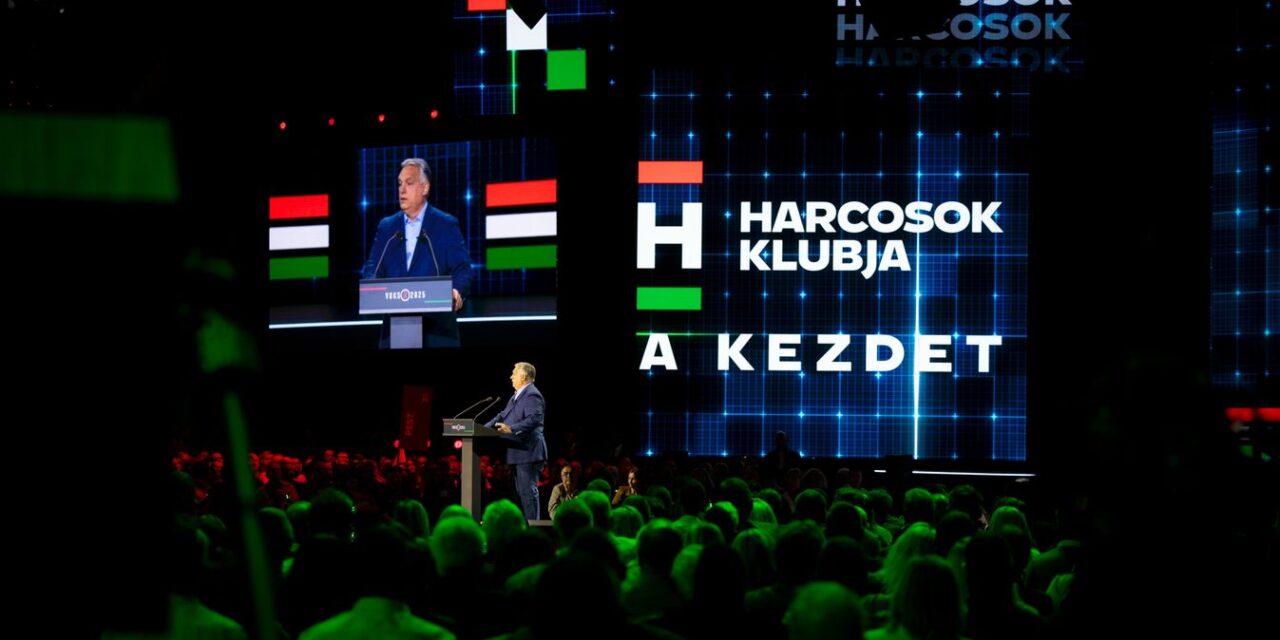Hungarian Prime Minister Viktor Orbán at the inaugural event of Harcosok Klubja, May 18, 2025 (Fischer Zoltán)
On May 18 in Budapest, Hungary, right-wing group Harcosok Klubja (Fight Club) emerged from Facebook secrecy for its first in-person campaign event.
“The Beginning” resembled “an MLM [multi-level marketing]team building event, a motivational trainer show, and an American megachurch service” all at once.
It lifted the curtain on Prime Minister Viktor Orbán’s tactics for Hungary’s 2026 Parliamentary elections, rallying his supporters in the online sphere and flooding the zone, this time with user-made content instead of political ads.
Fostered by ruling party Fidesz and Orbán himself, HK is part of a haphazard effort to counter the ever-growing online opposition to the government, not by changing policy or solving the economic crisis rattling Hungary but by releasing their “freedom fighters of the digital world” to spread “truth of the Hungarians“.
Cognitive Dissonance
The irony of the name Fight Club seems to have been lost on both Fidesz and HK members. The famous book and even more famous movie adaptation from 1999 is a story about the struggles of an insomniac (The Narrator) with reality. With his internal conflict spurring cognitive dissonance, he manifests a faux solution to the problems of the world around him: a stronger, more masculine” alter ego that leads him and his followers into disorder and chaos.
HK mirrors the same dissonance in an aggressive response to a narrow interpretation of the truth. The movement is either Fidesz’s attempt to provoke disorder and anger at current affairs while distracting all parties from the cause, or a badly-named rallying cry to strengthen the personal cult of Orbán.
Like Project Mayhem in Fight Club, HK’s unintended message is that Orbán, their Narrator, is the polar opposite of a strong, capable leader with a clear plan.
Which begs the question: what were they thinking?
Digital “Freedom Fighters”
While Fidesz and HK claim that Fight Club is a fresh venture in the online sphere, the formation of the group echoes the party’s well-known social media advertisement tactics. Megafon, a right-wing social media incubator, has long been the promoter of pro-government posts and political ads on platforms like Facebook. It has spent record amounts on election campaign ads as it promoted Fidesz’s agenda. It has offered “right-wing digital freedom fighter” training courses, and has hosted “Freedom Fight” events.
The shift with HK is the recruitment of unpaid voices. Despite the overwhelming number of ads by Fidesz and Megafon on Facebook, they cannot penetrate comment sections and left-wing “for you” pages. The very Trumpian response is to use a few key actors, such as Orbán, plant narratives in online leftist spaces that are pro-Fidesz, and amplify them through organic engagement.
In his call-to-action speech at the inaugural event in May, Orbán encouraged members to get involved in the “good fight”; recruit active fighters (no bystanders allowed); and take the side of “truth” against false narratives.
Although the Prime Minister mentioned the usual suspects (Brussels, George Soros, and Ukraine’s European Union bid) in his address, it is clear that HK’s primary enemy — particularly in the online world — is the ever-growing Tisza Party.
Headed by ex-Fidesz confidant Péter Magyar, Tisza has been far ahead in the digital world since its emergence in 2024. Amid the growing discontent of Hungarians, Magyar has not only amassed a considerable follower base but leads in organic engagement and self-organized support groups, “Tisza-islands”.
In the most recent polls, Tisza is leading with support from 33% of eligible voters, 4% ahead of Fidesz. That support is growing. Even if the trajectory slows, there is a good chance for a close fight in the 2026 Parliamentary elections.
Facade, Failure, or Both?
Fidesz’s aim with HK is to drown out the growing online following of Magyar and reclaim the digital sphere. But data on engagement indicated HK had little success after its launch. There was no sign of a doubling in the number of members, the goal set out by Orbán in his speech.
Tisza reacted with a shrug and a chuckle. Magyar said HK is merely an act, a facade to cover up whatever election interference Fidesz is planning:
It will obviously be Russian or Chinese bots, Vietnamese like-farms, or I-don’t-even-know-what …This is not
about them having, now or in the future, 20-40-100,000 fighters. It’s about covering all of that up.
Chuck Palahniuk, the author of Fight Club, gave advice to Tisza. “The opposition, if it were to get organized, could perhaps use the title of my third book, Invisible Monsters,” he told Economx.
The rebrand may not be necessary. Magyar’s monsters are quite visible – and scary – to Fidesz already.
When Digital Conscription Fails
Fidesz doubled down on Fight Club with Harcosok Órája (The Hour of the Fighters), a podcast dedicated to “fighting for our truth, fighting against lies” and “telling [the audience] what is in the interest of Hungarians”. Debuting with an Orbán interview, the podcast has hosted Foreign Minister Péter Szíjjártó and right-wing, pro-Russia media personality Zsolt Bayer, a founding member of Fidesz.
It is the most public display of Fidesz’s roster of confidants, but it is failing, perhaps even more so than HK. Orbán’s interview garnered just over 300,000 views in its first two weeks online, and the initial four videos did relatively well on Facebook and YouTube combined, with around 1 million views in total. But most of those views were bought through Facebook ads, and between Szíjjártó’s first and second interviews, interest plummeted more than 92% from 214,000 to 16,000 thousand views.
At the end of July, Orbán announced the inception of Digitális Polgári Körök (Digital Citizen Circles) for private groups of Fidesz supporters, each with a different aim but working on the same goal of a “digital conquest” of Hungary. The Prime Minister’s rationale is that HK (and fighting) is “not for everyone” – but the distinction between HK and DPK is unclear.
From fighting “liberal fake news factories” with humor to winning back Budapest’s city administration from the opposition for “the true Hungarians”, there is a circle for everyone. The DPK claims that the groups will “protect Hungary’s sovereignty in the online sphere” through the three pillars of “remaining Hungarian, protecting freedom, and multiplying power”. That leads the conversation back to what it means to be “truly Hungarian”, a strong nationalist and anti-EU sentiment.
But Fidesz’s once-comprehensive digital strategy is now playing catch-up. In a near-confession to their scrambling, the goal of the first DPK meeting, hosted by Orbán, is “to discuss together: what next?”.
The National Algorithm
This is the “national algorithm” that Orbán wants to strengthen: an army of digital freedom fighters and patriotic civilians protecting his version of Hungary — an algorithm where Fidesz’s ideology reigns supreme, and anyone who questions it is betraying their country.
But Orbán has apparently forgotten to look in his own comment sections, where the true national algorithm is already flourishing with a voice of its own and without conscriptions or Narrators.
Support for Magyar is becoming synonymous with opposition to Fidesz. The Tisza Party is presenting itself as a beacon of hope for those wishing for the fall of an authoritarian system. Magyar is the most likely challenger to a Prime Minister who has been beyond challenge since Fidesz first took power in 2010.
Fidesz’s reconstruction of their campaign in the online sphere is a clear attempt to regain its commanding political voice — they call it a “digital conquest” for a reason — but they are losing their power in the online sphere.
They are losing it not only because of a botched communications campaign but also because they forget the first rule of starting a Fight Club: Even if you don’t talk about it, understand why it’s successful.
Fight Club should not be built on unconditional support for a single person. It should be a response to people’s concerns and aspirations, a promise of tangible change in return for action and advocacy — regardless of what the message is.
This may be what Magyar is doing. It certainly is not encapsulated in HK, the Harcosok Órája podcast, or even DPK.
And it may no longer be embodied by Viktor Orbán.

